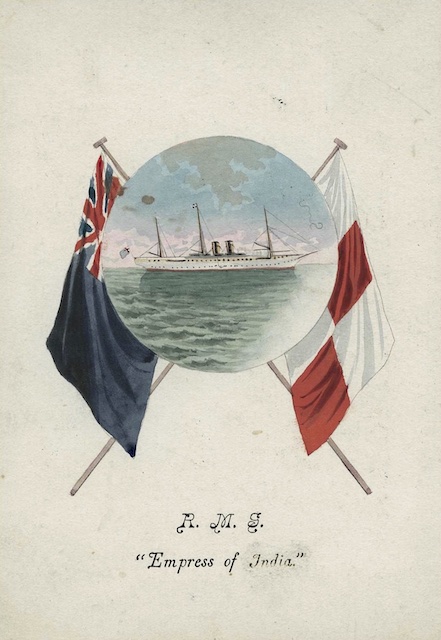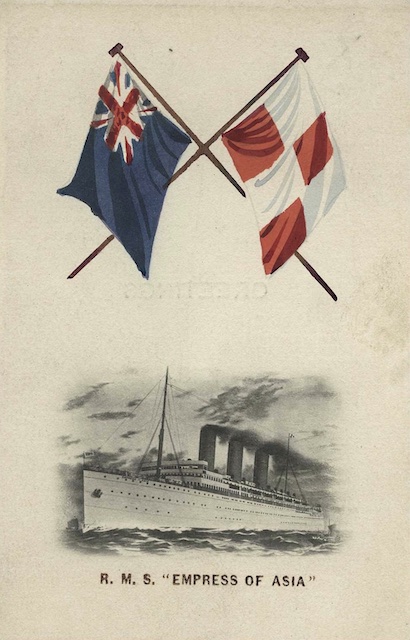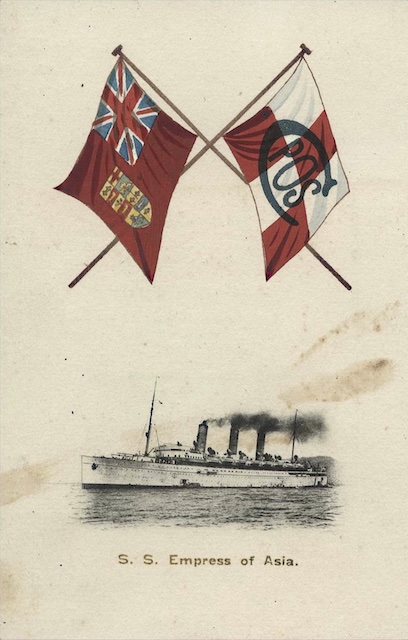Canadian Pacific’s first empresses were much smaller than its later ships and also, because they were slower, spent more time between ports. So I would have guessed that the menus they offered were much less elaborate than those found on board empresses of the 1930s or 1950s. Apparently, that’s not necessarily the case, at least judging by the first menu shown here.
 Click image to view and download a PDF of this menu from the University of British Columbia Chung collection.
Click image to view and download a PDF of this menu from the University of British Columbia Chung collection.
This 1905 lunch menu for the Empress of India has 51 different items (they are numbered, presumably to make it easier to order). These include four hors d’oeuvres, two kinds of fish, six hot and nine cold main courses, five different styles of potatoes (but only one vegetable), and five desserts. To be sure, the “salad” consists of six different items, such as lettuce, tomatoes, and radishes, each with their own number, so people could custom-make their own salads. Still, it is an impressive menu.
 Click image to view and download a PDF of this menu from the University of British Columbia Chung collection.
Click image to view and download a PDF of this menu from the University of British Columbia Chung collection.
This 1913 menu from the Empress of Asia is a little more sparse. It doesn’t say whether it is for lunch or dinner, but I’m inclined to lunch solely because it is so sparse. The items aren’t numbered but if they were there would be only about 30 of them — they can’t be counted accurately because hors d’oeuvres are listed simply as “hors d’oeuvres” and cheeses and beverages are also not distinguished. Of what we can see, there is only one soup, one fish course, three main hot courses and one cold.
 Click image to view and download a PDF of this menu from the University of British Columbia Chung collection.
Click image to view and download a PDF of this menu from the University of British Columbia Chung collection.
This 1919 menu from the same ship is even more sparse, listing just 16 items. This includes three hors d’oeuvres, one soup, one fish, two hot main courses, no cold main course, one vegetable, one potato, two salads, and two desserts. Like the previous menu, this one does not say whether it was for lunch or dinner, but even if it was for lunch, the menu doesn’t come close to the variety of the 1905 menu above.
One possible reason why the Empress of Asia menus are so different from the one from the Empress of India is class: the menus don’t say, but the Empress of India menu may have been for first-class travelers (of which there were up to 120) while the others might have been for second class (of which there were up to 50) or, less likely, steerage (of which there were up to 600).
A 1913 poster in the Chung collection gives an idea of the kind of food served to second- and third-class passengers. The poster lists four meals for each class. There was some variation by day; these are Monday’s menus.
Second class — Breakfast: Tea and coffee, hot rolls, bread, butter and marmalade, porridge, beefsteak, and Irish stew; Lunch: Vegetable soup, boiled cod and parsley sauce, stewed breast of lamb, Jardiniere, Mandalay curry and rice, cold roast beef and roast mutton, spiced beef, baked and mashed potatoes, salad, semolina pudding, jam puffs, cheese, dessert, coffee; Dinner: Soup, roast beef, haricot mutton, potatoes, pudding, biscuits and cheese; Supper: Tea & coffee, gruel, bread and butter, cheese and biscuits.
Third class — Breakfast: Oatmeal porridge and milk, steak and onions, Irish stew, bread and butter, preserves, coffee; Dinner: Soup and bouilli, roast mutton, boiled potatoes, cabbage, rice pudding; Tea: Smoked herrings, American hash, bread and butter, preserves, tea; Supper: Gruel, biscuits and cheese.
Passengers fed these meals wouldn’t go hungry, but the wealthy first-class passengers would have revolted if this is what they were offered. It’s curious that second-class passengers were served lunch and dinner while third class were served dinner and tea. Lunch/dinner was served at 12:30; tea at 5:30; dinner at 6:00; and supper at 8:30.
